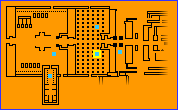
 The English writer Amelia Edwards, who traveled through Egypt in the 1870s,
described Karnak as "a place ... of which no writing and no art can convey more
than a dwarfed and pallid impression." We're the first to admit that the same
is true of these 360° images; the only real way to gain a sense of the
vastness of the Great Hypostyle Hall is to walk through it yourself. But until
you can get there, we hope images like this will suffice.
The English writer Amelia Edwards, who traveled through Egypt in the 1870s,
described Karnak as "a place ... of which no writing and no art can convey more
than a dwarfed and pallid impression." We're the first to admit that the same
is true of these 360° images; the only real way to gain a sense of the
vastness of the Great Hypostyle Hall is to walk through it yourself. But until
you can get there, we hope images like this will suffice.
|  The openwork stone windows known as claustra once lined both sides of the
Hall's central gallery.
The openwork stone windows known as claustra once lined both sides of the
Hall's central gallery.
|
In this 360° image, you begin facing north towards the center aisle of the
Hall, which follows the east-west direction of the early-morning sunlight.
Notice the grid-like structure atop the pillars rising in the center of the
image. These so-called "claustra," or openwork windows in stone, once lined the
sides of the central gallery and allowed shafts of light to angle pleasingly
into the interior.
 Gustave Flaubert's "palace of giants."
Gustave Flaubert's "palace of giants."
|
|
Turning to the right (east), you'll see the obelisk of Tuthmosis I silhouetted
against the rising sun. To the south and west, where dozens of pillars crowd
one another for space, you can understand why Gustave Flaubert, on his visit to
Karnak in the 19th century, called the temple "a palace of giants." Keep your
eyes peeled for scaffolding, which workers utilize in the Hall's ongoing
restoration.
|
 |




 The English writer Amelia Edwards, who traveled through Egypt in the 1870s,
described Karnak as "a place ... of which no writing and no art can convey more
than a dwarfed and pallid impression." We're the first to admit that the same
is true of these 360° images; the only real way to gain a sense of the
vastness of the Great Hypostyle Hall is to walk through it yourself. But until
you can get there, we hope images like this will suffice.
The English writer Amelia Edwards, who traveled through Egypt in the 1870s,
described Karnak as "a place ... of which no writing and no art can convey more
than a dwarfed and pallid impression." We're the first to admit that the same
is true of these 360° images; the only real way to gain a sense of the
vastness of the Great Hypostyle Hall is to walk through it yourself. But until
you can get there, we hope images like this will suffice. The openwork stone windows known as claustra once lined both sides of the
Hall's central gallery.
The openwork stone windows known as claustra once lined both sides of the
Hall's central gallery.
 Gustave Flaubert's "palace of giants."
Gustave Flaubert's "palace of giants."